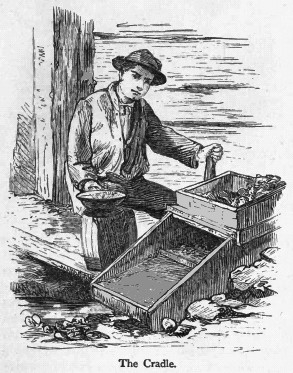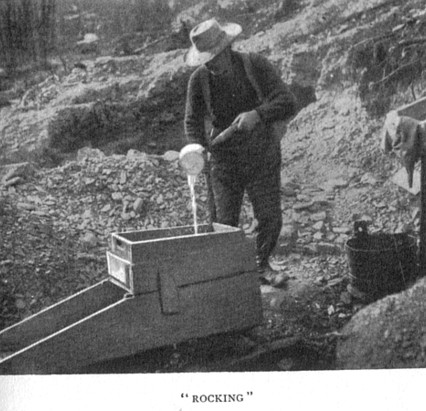The rocker or cradle is still less efficient than the long tom and inferior in capacity. It bears some resemblance in shape and size to a child's cradle, and rests upon similar rockers. The cradle-box is about forty inches long, twenty wide, and four high, and it stands with the upper end about two feet higher than the lower end, which is open so that the tailings can run out. On the upper end of the cradle-box stands a hopper or riddle-box twenty inches square, with sides four inches high. The bottom of this riddle box is of sheet-iron, perforated with holes half an inch in diameter. The riddle-box is not nailed to the cradle-box, but can be lifted off without difficulty. Under the riddle is an "apron" of wood or cloth, fastened to the sides of the cradle-box and sloping down to the upper end of it. Across the bottom of the cradle-box are two riffle-bars about an inch square, one in the middle, the other at the end of the box. The dirt is shoveled into the hopper, the " cradler " sits down beside his machine, and while with one hand with a ladle he pours water from a pool at his side upon the dirt, with the other he rocks the cradle. With the water and the motion the dirt is dissolved, and carried down through the riddle, falling upon the apron which carries it to the head of the cradle box, whence it runs downward and out, leaving its gold, black sand, and heavier particles of sand and gravel behind the riffle bars.
The man who rocks a cradle learns to appreciate the fact, that the "golden sands" of California are not pure sand, but are often extremely tough clay, a hopper full of which must be shaken about for ten minutes before it will dissolve under a constant pouring of water. Many large stones are found in the pay-dirt. Such as give an unpleasant shock to the cradle, as they roll from side to side of the riddle-box, are pitched out by hand, and after a glance to see that no gold sticks to their sides, are thrown away; but the smaller ones are left until the hopper full has been washed, so that nothing but clean stones remain in the riddle, and then the cradler rises from his seat, lifts up his hopper, and with a jerk throws all the stones out. The water and the rocking are both necessary. Without the water, the dirt could not be washed; and without the rocking, the dirt would dissolve very slowly, and the gold would most of it be lost. The rocking keeps the dirt in the bottom of the cradle more or less loose, so that the particles of gold can sink down in it, whereas if the cradle stood still, the sand there would almost immediately pack down into a hard floor, over which the gold would urn almost as readily as over a board. The whole business of washing with a cradle, is a repetition of the process already described some dirt, about one-third or one-fourth of what the hopper would hold, if full, is put into the hopper, and while the cradle is rocked with one hand, the other pours in the water. The cradle is cleaned up two or four times in a day. The cleaning up is done by lifting the hopper, taking out the apron, scraping up all the dirt in the bottom of the cradle with an iron spoon, putting it into a pan and washing out the dirt, so that only the natural gold will be left. This last process is called panning out, and will be described in the next section. Most of the gold collects above the upper riffle-bar, including all the larger lumps.
If the apron be of rough woolen cloth, some of the fine gold will be caught there. In diggings where the gold is very fine, the hopper is sometimes placed over the lower end of the cradle, and the apron is made twice as long, and with a lower inclination than in the more common form of the rocker. The water for the cradle should be supplied by a little ditch, with a reservoir at the head of the cradle, to contain five or six gallons. The dipper should be of tin, shaped like a basin, hold about a gallon when full, and have a handle an inch and a half in diameter, and eight inches long. The difference of height between the upper and lower ends of the cradle should not be more than two inches : a steeper inclination will make the current running through it too strong, and the gold will be carried off; and, on the other hand, if the cradle be nearer a level it will be hard to rock, and the dirt in the bottom will pack more rapidly. The amount of dirt that can be washed in a day with a cradle, varies from one to three cubic yards. The dirt is usually shoveled into a gold pan or bucket, from which it is thrown into the hopper. The miners usually measure the amount of dirt washed by the number of "pans." One man working alone with a Cradle ought to wash from seventy-five to one hundred and fifty pans in a day, and two men will wash twice as much. A pan may contain one-third or one half of a cubic foot. Two men can work more conveniently with the rocker than one. There is enough work to give constant employment to a cradler and a person to shovel. The latter has a couple of buckets or pans, which he fills alternately, always keeping one full and near the cradler, so that without moving his feet he can pick it up and empty it into the riddle-box. If the rocker have only one man, he must stop rocking after washing every pan and get more dirt. This delay is injurious to the process of washing, because it allows the dirt in the bottom of the cradle to harden and pack, and some gold is always lost as a consequence. If the dirt and water be convenient, not more than two men can work to a profit with a rocker. But sometimes it happens that water cannot be led to the claim, and in such case the dirt must be carried to the water, a greater weight of which is used than of dirt.
At least three times as much water as dirt is required for washing. If the distance from the hole to the water be not over ten or twenty feet, the miners will usually carry the dirt in buckets ; if farther they will use wheelbarrows ; and sometimes for greater distances pack-mules or wagons. The greater the distance, the more the men required for carrying the dirt. Sometimes, too, it happens that the claim is troubled by water, and then one man may be constantly employed in bailing. It is of great importance in mining with the cradle, to have the cradle placed within four or five feet of the hole from which the pay-dirt is obtained, and to have a good supply of water at the head of the cradle, and then to have a good descent below the cradle, so that the tailings may all be carried away by the water, so as not to accumulate. The rocker washes about one-half the amount of dirt that can be washed by an equal number of men with the torn, one-fourth of what can be washed with the sluice, and one-hundredth of the amount that can be washed with the hydraulic process ; but it is peculiarly fitted for some kinds of diggings.
Many little gullies, containing coarse gold in their "beds, cannot obtain water for washing except during rains, and then only for a few days at a time. In these gullies the cradle can be used to the best advantage, for it can easily be transported, and it is very good for saving coarse gold. While dirt that would pay from ten to twenty-five cents per pan full, was abundant at the surface of the earth during the California gold rush, the cradle was extensively used, but itís use was soon abandoned by the American miners, and left to the Chinamen, who thought themselves doing well if they made seventy-five cents to one dollar per day. 'The great difficulty in mining with the cradle is, that the sand will "pack," or make a hard mass on a level with the top of the riffle-bars, and the gold then is lost. So long as the cradle is in motion the dirt does not pack, but when the rocking ceases, the mass hardens in a few minutes. If the miner leaves his cradle standing for fifteen minutes, he stirs up the dirt with his spoon before commencing again to wash. One device to prevent packing is to put a little block under each end of the rockers, so that at the end of every motion the cradle receives a shock. Quicksilver was sometimes used in cradles for amalgamation, but not usually.
Rockers or cradles and sluice boxes were the next devices used by the early-day miners. The rocker is a crude concentrating machine made of wood that combines the shaking motion of the pan with some of the features of the sluice. The 'rocker' is a box about 4 ft. long and 2 ft. wide, and is mounted on semicircular pieces of wood and worked by a, handle to give it a side motion; and it is also inclined so as to carry the material down to the lower end, which is open. At the upper end is a small hopper that may be removed and which has a sheet-iron bottom perforated with half-inch holes. Under the hopper is a canvas apron or tray inclined toward the head of the box but touching neither end of the hopper-box. A series of wooden riffles are placed across the box between the centre and lower end. The material is fed into the hopper and screened through by water poured on top ; the lighter material is carried over the end, while the riffles catch the gold and magnetic sand. This residue is panned at the end of the operation. The rocker is effectively a combination of a sieve and a moving sluice.
Continue on to:
Using a Sluice Box, Part I - Historic placer Mining
Return To:
Historic Placer Mining Technologies


